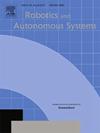RUMOR: Reinforcement learning for understanding a model of the real world for navigation in dynamic environments
IF 4.3
2区 计算机科学
Q1 AUTOMATION & CONTROL SYSTEMS
引用次数: 0
Abstract
Autonomous navigation in dynamic environments is a complex but essential task for autonomous robots, with recent deep reinforcement learning approaches showing promising results. However, the complexity of the real world makes it infeasible to train agents in every possible scenario configuration. Moreover, existing methods typically overlook factors such as robot kinodynamic constraints, or assume perfect knowledge of the environment. In this work, we present RUMOR, a novel planner for differential-drive robots that uses deep reinforcement learning to navigate in highly dynamic environments. Unlike other end-to-end DRL planners, it uses a descriptive robocentric velocity space model to extract the dynamic environment information, enhancing training effectiveness and scenario interpretation. Additionally, we propose an action space that inherently considers robot kinodynamics and train it in a simulator that reproduces the real world problematic aspects, reducing the gap between the reality and simulation. We extensively compare RUMOR with other state-of-the-art approaches, demonstrating a better performance, and provide a detailed analysis of the results. Finally, we validate RUMOR’s performance in real-world settings by deploying it on a ground robot. Our experiments, conducted in crowded scenarios and unseen environments, confirm the algorithm’s robustness and transferability.
谣言:用于理解动态环境中导航的现实世界模型的强化学习
动态环境中的自主导航是自主机器人的一项复杂但重要的任务,最近的深度强化学习方法显示出有希望的结果。然而,现实世界的复杂性使得在每个可能的场景配置中训练代理是不可行的。此外,现有的方法通常忽略了机器人动力学约束等因素,或者假设对环境有完全的了解。在这项工作中,我们提出了RUMOR,一种新的差动驱动机器人规划器,它使用深度强化学习在高动态环境中导航。与其他端到端DRL规划器不同,它使用描述性的以机器人为中心的速度空间模型来提取动态环境信息,提高训练效率和场景解释。此外,我们提出了一个固有地考虑机器人动力学的动作空间,并在再现现实世界问题方面的模拟器中训练它,减少了现实与模拟之间的差距。我们将RUMOR与其他最先进的方法进行了广泛的比较,展示了更好的性能,并提供了对结果的详细分析。最后,我们通过在地面机器人上部署RUMOR来验证其在现实环境中的性能。我们在拥挤的场景和不可见的环境中进行的实验证实了该算法的鲁棒性和可移植性。
本文章由计算机程序翻译,如有差异,请以英文原文为准。
求助全文
约1分钟内获得全文
求助全文
来源期刊

Robotics and Autonomous Systems
工程技术-机器人学
CiteScore
9.00
自引率
7.00%
发文量
164
审稿时长
4.5 months
期刊介绍:
Robotics and Autonomous Systems will carry articles describing fundamental developments in the field of robotics, with special emphasis on autonomous systems. An important goal of this journal is to extend the state of the art in both symbolic and sensory based robot control and learning in the context of autonomous systems.
Robotics and Autonomous Systems will carry articles on the theoretical, computational and experimental aspects of autonomous systems, or modules of such systems.
 求助内容:
求助内容: 应助结果提醒方式:
应助结果提醒方式:


